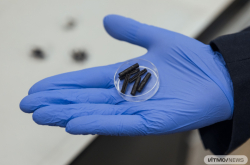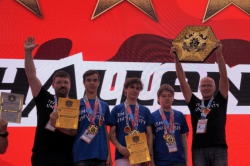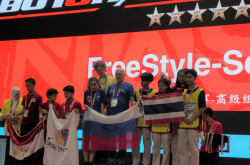About the competition
The World Robot Olympiad has been held since 2004. This is a competition of robots built using LEGO Mindstorms construction kits, in three categories: basic, creative and among robotic soccer players. As of now, in the regional and final stages of the competition there are about 20 thousand teams involved from almost 60 countries. Every year, a specific theme is chosen for the event. This year the robots have to show how they can contribute to the sustainable development of our planet. They face challenges related to the development of ecological tourism, alternative energy sources, as well as to reduce the carbon footprint (reduced CO2 emissions).
In order to make it into the finals, the teams go through a regional qualifying round. In June, the school team from the creative robotics lab at the School of Computer Technologies and Management was the winner of the Russian Robot Olympiad with their Forester Project in the creative category in the senior age group. The team included students Gleb Zagarskikh, Daniil Nechaev and Maksim Mikhailov under the guidance of coaches Igor Lositsky and Evgeny Zavarin. All the robot-makers come from different schools in St. Petersburg. Daniil Nechaev has already participated in WRO, Maksim Mikhailov joined the team only a year ago, but showed good skills, said the coach.

However, in order to get into the national team, there was another selection process where 12 teams from 10 regions of Russia had to provide a project description and video presentation of their project in Russian and English.
"For teams that make it into international competitions, it’s of vital importance that they can clearly explain in English, to the jury, what their robot does and its functions. They are given only five minutes for this. It’s important that the judges can easily understand the features of the robot, and how it fits into the stated theme of the competition. Then the students answer questions from the jury. The robot is in a special exhibition area, where all the conditions are set for its normal operation. The event is open for the public ", shares Igor Lositsky, the team’s coach from ITMO University’s Department of Control Systems and Informatics.
About Forester
The terrain-crossing robot Forester (at the lab he is referred to as a “forest pathologist robot”) tracks forest health with the efficiency of ten human workers: it collects data on the state of trees, identifies areas of the forest that need to be felled and helps prevent forest fires.

In practice, the robot will be applied in such manner: a quadcopter delivers it to the area of the forest that needs to be analyzed. From there, the robot continues on its own. Using a camera and a set of algorithms, it can keep track of where it is in relation to its landing zone. Special sensors help precisely measure distance to an object and determine where a tree is, what kinds of tree it is and what state it’s in.

Before the Russian qualifying round of the WRO, the robot participated in a city-wide competition. Since then, the robot has gone through several transformations. So at the St. Petersburg competition, the robot could travel quickly but couldn’t “walk” yet. By the time it got to the Russian competition, Forester could already walk. By the time it gets to the international exhibition, it’ll already have “brains”.
"The boys created a neural network for the robot, with which it can identify tree species. Earlier, we used more primitive and unreliable methods. We’ve already improved the construction of the model, and sorted out all the mechanisms.” – said Igor Lositsky.
He stressed that all the work on commissioning and creation of the robot was done independently by the students, and he, as a coach, could only give them advice and guide them in the right direction.






